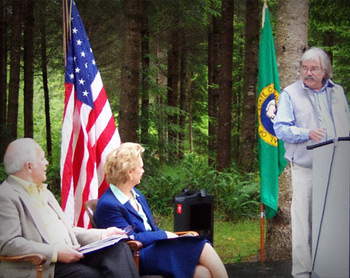Bill Wilkerson (1996-2006)
The Salmon Recovery Issue Highlights the Power of Collaboration
Under Bill Wilkerson’s watch, the pending Endangered Species Act listing of salmon and Clean Water Act water quality requirements, the timber industry entered into an expanded TFW collaborative forum to develop a state-based plan for fish habitat and water quality protection. While changing forestry practices alone couldn’t save salmon, the goal was for private forest landowners to do their fair share for the statewide strategy to recover salmon. Private forest landowners wanted to be the first to step up to the plate, prior to any federal listings.
In May 1997 another round of TFW talks were started, this time expanded to six caucuses (federal, state, county, tribal, environmental, and landowner). After 18 months of negotiation, the groups came to an agreement known as the Forests and Fish Report.
By May 1998, the Forest Practices Board had adopted emergency rules in response to federal listings of salmon and was followed by legislation adopting the Forests and Fish Report on April 29, 1999. The law increased buffers of trees alongside 60,000 miles of streams on 9.3 million acres of state and private forestland, improved road maintenance standards and increased protection for steep and unstable slopes.
Permanent Forest Practices Rules were adopted in 2001 and the comprehensive Road Maintenance and Abandonment Plan program was initiated to improve road infrastructure on more than 62,000 miles of roads.
More than 140 individuals, including 34 federal, state, county, tribal and industry scientists worked together for 18 months to develop this state-based plan that federal government scientists said meets the biological requirements of salmon and improves water quality on forested lands. One of the key components of the plan was agreement to use continually developing science, through the CMER process, and Adaptive Management (i.e. learning by doing) to guide the actions of foresters. This allows for Forest Practices Rules to change based on peer-reviewed scientific need. The program was endorsed for 50 years by the federal government in June 2006 as the largest multi-species Habitat Conservation Plan in the nation. ![]()

Wilkerson introduces Gov. Gregoire and Commissioner Sutherland at the Forests & Fish Habitat Conservation Plan signing ceremony.
